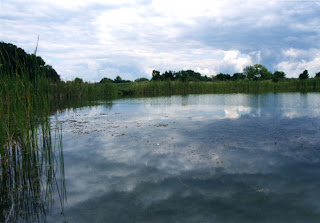by Brigette L. Camarata (Photographs by Marcus Holloway)

In January 1984, the start of Metea Park was underway. The park is located in north central Allen County and borders Cedar Creek. The initial parcel, 104 acres of land, was purchased by the Allen County Parks and Recreation Department with Rivergreenway money. Along the Maumee, St. Mary’s and St. Joseph’s rivers, a series of bike paths and parks, make up the Rivergreenway. Rivergreenway funds are distributed by the state to obtain and develop land, like that around Cedar Creek.

After the land was purchased, a 1.4 acre pond with beach was soon built and the park opened to the public in 1989. Since then, the park has grown to almost 250 acres. Metea Park has two miles of hiking trails and is home to a variety of wildlife.
While the park was being created, they came up with a theme to base it on the Woodland Indians of the area and their contributions.
Metea, which means “Kiss Me” in his native language, was born in 1778 and died in 1827. Metea was a Potawatomi Chief who came to the surrounding Ft. Wayne area in 1800. He was accompanied by his brother, as Metea’s rank required somone to light his pipe and perform various other duties as requested. Metea was approximately six feet tall, had high and prominent cheek bones, small elongated black eyes and painted red around one of them.
Metea was a great speaker and diplomat. Some people thought he was the greatest chief of the Indian nation. Even though he was not the head chief, he gained his status through his skills as a warrior and speaker in the councils of his nation. He was respected by the Americans and had a lot of influence with the Indians. He took part in many battles, treaty assemblies, and conferences. Metea was generous to his friends and would never betray them.
In 1812, war was brewing between the Indians, who were allies with Great Britain, and the United States who were allies with the French. Metea led the Indians to the attack on Ft. Wayne to try and stop Harrison’s army from advancing. Metea went ahead of his men, found part of Harrison’s army and hid behind a tree, accidently leaving part of his elbow exposed. Major Mann, an American, saw Metea’s arm sticking out and took a shot. It crushed his elbow and left his arm useless for the rest of his life. He retreated towards his men with the Americans following close behind but was still able to escape. After the war was over, Metea received an annual payment from the British for the loss of use of his right arm.
In 1827, he attended what was to be his last council meeting. After several days of difficult negotiations he wanted to celebrate with a drink and eventually got intoxicated. It is unknown whether he accidentally drank poison while he was drinking whiskey one night or if his fellow Indians poisoned him in retaliation of the treaty Chief Metea signed, which turned a large amount of land over to the U.S. Government. Metea died shortly after drinking the poison.

No comments:
Post a Comment